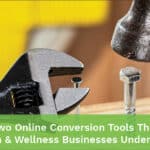Are you chasing butterflies? How much time does your wellness business spend on social media? Email? What sales, marketing, and customer satisfaction objectives does it accomplish? If you don’t know, you’re just doing busy work.
A lot of wellness businesses have “bright shiny object” syndrome. The newer and more hyped a tool is, the more time they spend on it. But the landscape can change rapidly.
Today’s Facebook can be tomorrow’s MySpace. Facebook’s reach has been dropping. Yahoo’s email delivery problems and unilateral interface changes, combined with Constant Contact’s recent outage, remind us that even “old reliable” email isn’t without risks. And who’s to say everyone won’t be walking around talking to their glasses in a few years? There’s a real risk to hanging our hats on just one technology. Time moves on, and our ability to reach customers with technology can suddenly disappear or diminish. It’s a stark reminder that we should never chase technology for technology’s sake.
To protect and grow your wellness business, keep in mind these key principles in formulating a web strategy:
1. Use technology as a means to an end, such as building a reputation in your area of wellness, gathering and qualifying leads, providing information, or processing sales transactions. Focus on fundamentals and sound business principles rather than the technology itself. It’s just a tool, and while tools change, objectives rarely do.
2. “Bulletproof” your web strategy with multiple tools. For instance, use social to establish and maintain the value of your services in relevant communities (e.g., hot yoga groups, cycling enthusiasts, weightlifting forums), and guide people to your website. Use your website to answer questions and qualify leads. Use the information you gather over time to leverage other ways to reach customers when existing tools fail, change, or stop being effective.
3. Always have a ‘Plan B,’ especially if you pay a monthly fee to use software rather than owning it. Be ready to use another tool to accomplish the same task — for instance, emailing customers individually, sending out physical flyers, or texting them with updates and offers. Most importantly, never trust the only copy of your client list to your online newsletter software.
4. Web and non-web tools should complement and even overlap each other. Just because email’s a great way to tell people about your new kickboxing + Pilates program doesn’t mean you should stop telling folks in person. If you’ve been successful in the past with flyer marketing, keep doing it; don’t suddenly ditch it and throw everything into Facebook ads.
5. Use the right tech for the right audience at the right time. Marketing — especially when it involves healthy behavior change — may take multiple exposures on different media to leave an impression, and some tech may work better than others reaching your particular prospects. Texting corporate wellness clients may not be as effective as email or webinars; mobile-friendly content and offers may be more effective with consumers. If your brand is attractive to customers with a strong sense of community (for instance, physically active diabetics, equestrians, or cancer survivors), social may be more effective than for general audiences.
6. Get your hands dirty. What’s fun is seldom the stuff that keeps your wellness business profitable. By building a solid sales, marketing, and operations model that leverages technology to accomplish relevant business goals, chances are good you’ll outlast fads, weather outages, and outperform competitors.


